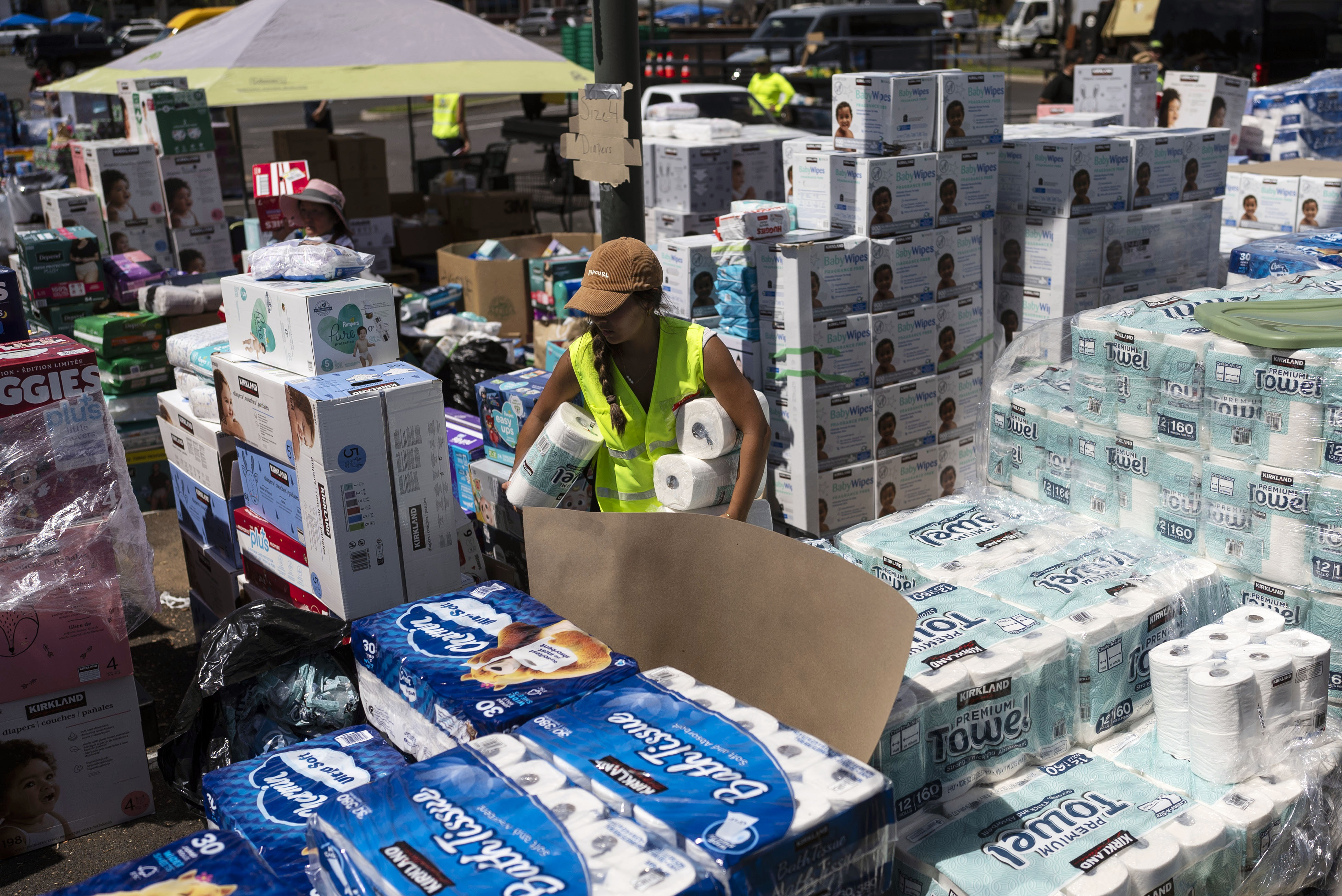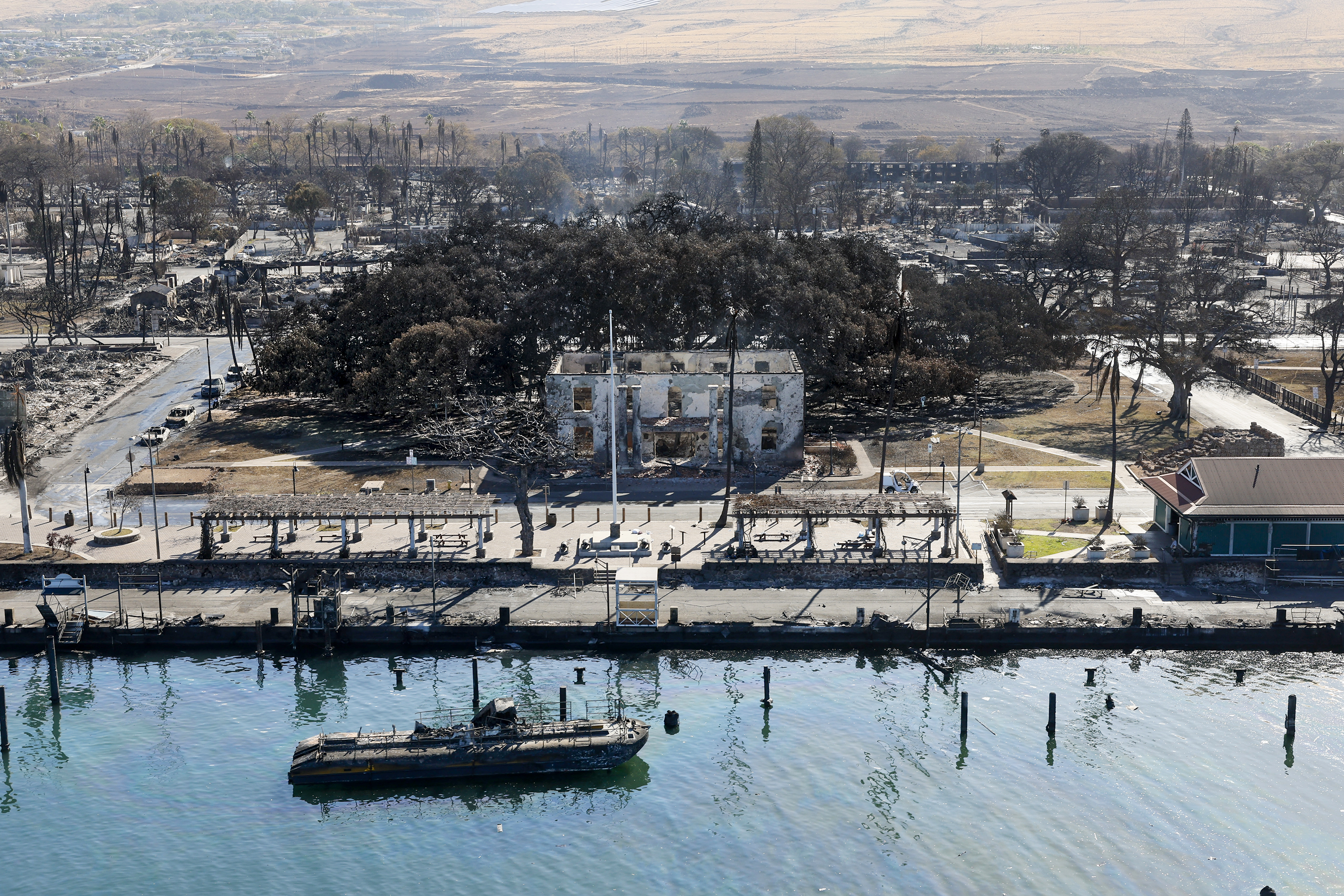Hawaii officials worked painstakingly to identify the 99 people confirmed killed in wildfires that ravaged Maui and expected to release the first names Tuesday, even as search teams continued to scour neighborhoods reduced to ash for more dead.
A week after the deadly blaze that leveled most of historic Lahaina began, many who survived have begun moving into hundreds of hotel rooms set aside for displaced locals.
Crews had covered about 25% of the search area, the police chief said Monday. Police Chief John Pelletier told NBC's "TODAY" show that the search, which is being conducted with dogs, was going slowly because the animals were getting tired from the heat and rough terrain. He said the emotional toll is draining not just for the town, but also their local rescuers.
"I don't think anybody is prepared to have this type of situation," Pelletier said Tuesday morning. "And let's realize this. When folks are shifting through burn debris, and dust is on you, it's not just dust on you. It's our dead. And I don't think anybody really is used to that when they go home and they take off the uniform. And it's really somber to think about that."
Get top local stories in DFW delivered to you every morning. Sign up for NBC DFW's News Headlines newsletter.
Gov. Josh Green asked for patience and space to do the search properly as authorities became overwhelmed with requests to visit the burn area.
“For those people who have walked into Lahaina because they really wanted to see, know that they’re very likely walking on iwi,” he said at a news conference on Maui, using the Hawaiian word for “bones.”
Just three bodies have been identified so far and officials will start releasing names on Tuesday, according to Maui Police Chief John Pelletier, who renewed an appeal for families with missing relatives to provide DNA samples.
Green warned Monday that scores more bodies could be found. The wildfires, some of which have not yet been fully contained, are already the deadliest in the U.S. in more than a century. The cause was under investigation.
Authorities paused a system that had allowed Lahaina residents and others to visit devastated areas with police permits. Kevin Eliason said when he was turned away, the line of cars with people waiting to get a placard had grown to at least 3 miles (5 kilometers) long.
“It’s a joke,” Eliason said. “It’s just crazy. They didn’t expect, probably, tens of thousands of people to show up there.”
The blaze that swept into centuries-old Lahaina last week destroyed nearly every building in the town of 13,000. That fire has been 85% contained, according to the county. Another blaze known as the Upcountry fire has been 65% contained.
Even where the fire has retreated, authorities have warned that toxic byproducts may remain, including in drinking water, after the flames spewed poisonous fumes. That has left hundreds unable to return home.
The Red Cross said 575 evacuees were spread across five shelters on Monday, including the War Memorial Gymnasium in Wailuku. Green said that thousands of people will need housing for at least 36 weeks.
More than 3,000 people have registered for federal assistance, according to the Federal Emergency Management Agency, and that number was expected to grow.
“We’re not taking anything off the table, and we’re going to be very creative in how we use our authorities to help build communities and help people find a place to stay for the longer term,” agency administrator Deanne Criswell said.
FEMA has started to provide $700 to displaced residents to cover the cost of food, water, first aid and medical supplies. The money is in addition to whatever amount residents qualify for to cover the loss of homes and personal property.
The Biden administration is seeking $12 billion more for the government’s disaster relief fund as part of its supplemental funding request to Congress.
Meanwhile, the local power utility has faced criticism for not shutting off power as strong winds buffeted a parched area under high risk for fire. It’s not clear whether the utility’s equipment played any role in igniting the flames.
Hawaiian Electric Co. Inc. will cooperate with the state’s investigation as well as conducting its own, President and CEO Shelee Kimura said.
Kimura said many factors go into a decision to cut power, including the impact on people who rely on specialized medical equipment. She also noted that shutting off power in the fire area would have knocked out water pumps.
“Even in places where this has been used, it is controversial and it’s not universally accepted,” she said.
Fueled by dry grass and propelled by strong winds from a passing hurricane, the flames on Maui raced as fast as a mile (1.6 kilometers) every minute in one area, according to Green.
As firefighters battled the flames last week, a flurry of court actions were lodged over access to water.
Some state officials say there is not enough water available for firefighters in central Maui, and blame a recent ruling by an environmental court judge. The ruling did not directly affect water supplies to Lahaina, the attorney general's office said Monday.
On Wednesday morning, Judge Jeffrey Crabtree issued an order temporarily suspending water caps he imposed for 48 hours. The judge also authorized water distribution as requested by Maui fire officials, the county or the state until further notice if he could not be reached.
But that wasn’t enough for the state attorney general’s office, which later filed a petition with the state Supreme Court blaming Crabtree for a lack of water for firefighting. The state asked the court not to let Crabtree alter the amount of water to be diverted or to put a hold on his restrictions until the petition is resolved.
It’s part of a long-running battle between environmentalists and private companies over the decadeslong practice of diverting water from streams that started during Hawaii’s sugar plantation past.
___
Kelleher reported from Honolulu, and Weber from Los Angeles. Associated Press journalists Haven Daley in Kalapua, Hawaii; Beatrice Dupuy in New York; and Josh Boak in Washington contributed.



